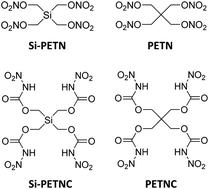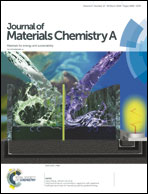Reaction mechanisms and sensitivity of silicon nitrocarbamate and related systems from quantum mechanics reaction dynamics†
Abstract
Temperature induced instability is an important issue in developing new molecules and materials, but there is no clear understanding about how the molecular structure and crystal packing control sensitivity. This is particularly the case for energetic materials (EMs) important in propulsion and detonation. We propose here the use of quantum mechanics molecular dynamics (QM-MD) based temperature programmed reaction dynamics for predicting the relative sensitivity of various materials while simultaneously obtaining the underlying reaction mechanisms to provide guidance in improving materials. We illustrate this for four closely related molecules, pentaerythritol tetranitrate, pentaerythritol tetranitrocarbamate, and their silicon analogs, that have minor intramolecular differences but exhibit different sensitivities experimentally. Our study finds dramatic differences in reaction mechanisms and energy variation under heating that suggest explanations for the different sensitivities. Important here are both the initial decomposition and the secondary reactions between products. The higher sensitivity of the Si analogs originates from the highly exothermic Si–O bond formation as a paramount initial reaction that promotes other reactions, leading to the generation of various intermediates and final products, thus accelerating the decomposition process and energy release. The nitrocarbamates have low sensitivity because their large complex branching impedes the exothermic Si/C–O bond formation and triggers multiple initial endothermic reaction pathways with higher reaction barriers, delaying secondary exothermic reactions and energy release. We find two computational measures that correlate well with sensitivity: the temperatures at which the energy changes from endothermic to exothermic and the total absorbed energy. This study provides mechanistic insight into the molecular and structural determinants controlling the sensitivity of EMs and provides a practical way to predict the relative sensitivity prior to experimental synthesis and characterization, benefiting the design of novel EMs.



 Please wait while we load your content...
Please wait while we load your content...